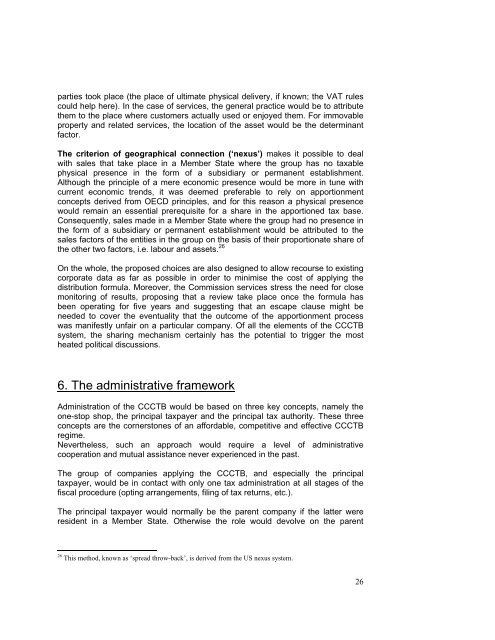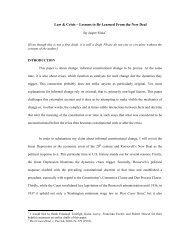An outline of the CCCTB (Common Consolidated Corporate Tax ...
An outline of the CCCTB (Common Consolidated Corporate Tax ...
An outline of the CCCTB (Common Consolidated Corporate Tax ...
You also want an ePaper? Increase the reach of your titles
YUMPU automatically turns print PDFs into web optimized ePapers that Google loves.
parties took place (<strong>the</strong> place <strong>of</strong> ultimate physical delivery, if known; <strong>the</strong> VAT rules<br />
could help here). In <strong>the</strong> case <strong>of</strong> services, <strong>the</strong> general practice would be to attribute<br />
<strong>the</strong>m to <strong>the</strong> place where customers actually used or enjoyed <strong>the</strong>m. For immovable<br />
property and related services, <strong>the</strong> location <strong>of</strong> <strong>the</strong> asset would be <strong>the</strong> determinant<br />
factor.<br />
The criterion <strong>of</strong> geographical connection (‘nexus’) makes it possible to deal<br />
with sales that take place in a Member State where <strong>the</strong> group has no taxable<br />
physical presence in <strong>the</strong> form <strong>of</strong> a subsidiary or permanent establishment.<br />
Although <strong>the</strong> principle <strong>of</strong> a mere economic presence would be more in tune with<br />
current economic trends, it was deemed preferable to rely on apportionment<br />
concepts derived from OECD principles, and for this reason a physical presence<br />
would remain an essential prerequisite for a share in <strong>the</strong> apportioned tax base.<br />
Consequently, sales made in a Member State where <strong>the</strong> group had no presence in<br />
<strong>the</strong> form <strong>of</strong> a subsidiary or permanent establishment would be attributed to <strong>the</strong><br />
sales factors <strong>of</strong> <strong>the</strong> entities in <strong>the</strong> group on <strong>the</strong> basis <strong>of</strong> <strong>the</strong>ir proportionate share <strong>of</strong><br />
<strong>the</strong> o<strong>the</strong>r two factors, i.e. labour and assets. 26<br />
On <strong>the</strong> whole, <strong>the</strong> proposed choices are also designed to allow recourse to existing<br />
corporate data as far as possible in order to minimise <strong>the</strong> cost <strong>of</strong> applying <strong>the</strong><br />
distribution formula. Moreover, <strong>the</strong> Commission services stress <strong>the</strong> need for close<br />
monitoring <strong>of</strong> results, proposing that a review take place once <strong>the</strong> formula has<br />
been operating for five years and suggesting that an escape clause might be<br />
needed to cover <strong>the</strong> eventuality that <strong>the</strong> outcome <strong>of</strong> <strong>the</strong> apportionment process<br />
was manifestly unfair on a particular company. Of all <strong>the</strong> elements <strong>of</strong> <strong>the</strong> <strong>CCCTB</strong><br />
system, <strong>the</strong> sharing mechanism certainly has <strong>the</strong> potential to trigger <strong>the</strong> most<br />
heated political discussions.<br />
6. The administrative framework<br />
Administration <strong>of</strong> <strong>the</strong> <strong>CCCTB</strong> would be based on three key concepts, namely <strong>the</strong><br />
one-stop shop, <strong>the</strong> principal taxpayer and <strong>the</strong> principal tax authority. These three<br />
concepts are <strong>the</strong> cornerstones <strong>of</strong> an affordable, competitive and effective <strong>CCCTB</strong><br />
regime.<br />
Never<strong>the</strong>less, such an approach would require a level <strong>of</strong> administrative<br />
cooperation and mutual assistance never experienced in <strong>the</strong> past.<br />
The group <strong>of</strong> companies applying <strong>the</strong> <strong>CCCTB</strong>, and especially <strong>the</strong> principal<br />
taxpayer, would be in contact with only one tax administration at all stages <strong>of</strong> <strong>the</strong><br />
fiscal procedure (opting arrangements, filing <strong>of</strong> tax returns, etc.).<br />
The principal taxpayer would normally be <strong>the</strong> parent company if <strong>the</strong> latter were<br />
resident in a Member State. O<strong>the</strong>rwise <strong>the</strong> role would devolve on <strong>the</strong> parent<br />
26 This method, known as ‘spread throw-back’, is derived from <strong>the</strong> US nexus system.<br />
26
















